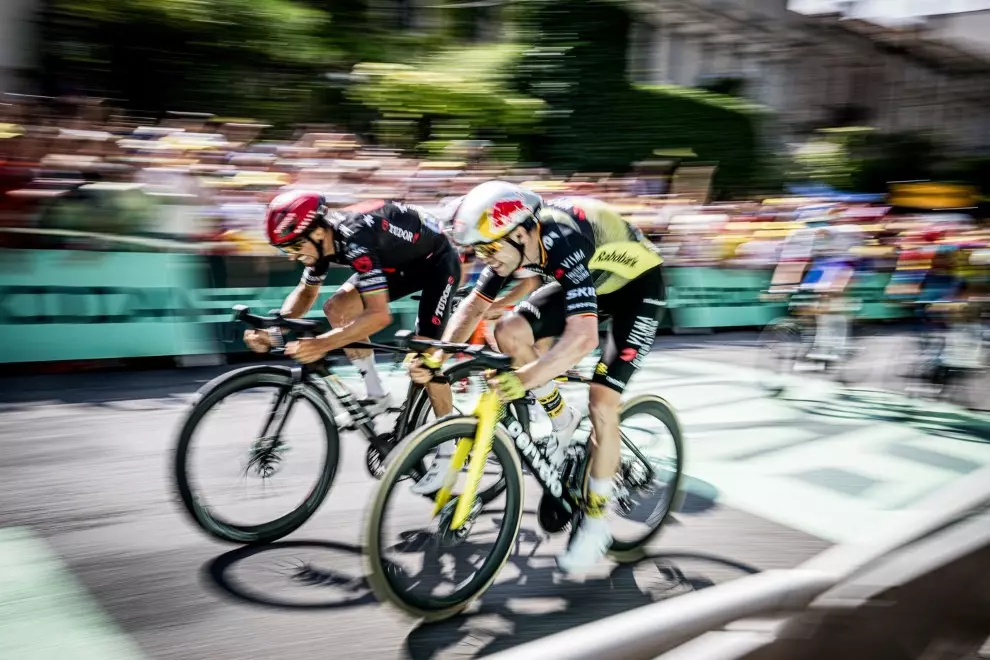That’s quite a raise from his 2024 salary of $6 million, but then he had a spectacular season in 2024, winning 25 races, including two Grand Tours, and is unanimously considered to be the best rider on the road and perhaps even the best ever.
It was then reported, first by the Italian publication Gazzetta dello Sport and then by other sources, that the cost of funding a team has grown by 33% since 2022, to a total annual budget of €570 million ($600 million) for all the current World Tour teams. The total budget for corresponding women’s teams was ‘only’ €70 million, although that represented a growth since 2022 of 100%.
Here is a list of the five largest budgets of the men’s World Tour teams, as estimated by procyclinguk.com:
- UAE Team Emirates: €55–€60 million.
- INEOS Grenadiers: €50–€55 million.
- Visma-Lease a Bike: €50–€55 million.
- Lidl-Trek: €30–35 million.
- Soudal–QuickStep: €25–€30 million.
It will be noted that three of these five teams had excellent seasons in 2024, especially the team with the top budget. Jumbo-Visma had its season ruined by a series of disastrous rider crashes but won all three Grand Tours in 2023, an unprecedented feat in the sport. (INEOS had long dominated the sport, both in terms of success and budget. Its failure to turn money into success over the past several years was down to bad luck and unfortunate decisions.)
This growth in funding and the relationship between money and success was also noticed by the magazine Bicycling, which went on to suggest that perhaps it isn’t fair that “cycling’s most prestigious races are being dominated by this small group of ultra-wealthy teams.” This led the author to raise the inevitable question: “Is it time for professional cycling to introduce a salary cap?”
Before I answer that question (alright, I’ll answer it now: no), it should be noted that in the world of professional sports, Pogačar’s salary – even if we add to it other monetary perks such as bonuses, appearance, and promotion fees – is really no big deal. This is because cumulative inflation over the years, as well as the entry into various sports, including cycling, of Mideast oil interests (such as the United Arab Emirates), has greatly upped the ante.
First of all, regarding inflation, there are today no fewer than 2,781 billionaires in the world, according to Forbesmagazine. In the year 2000, it counted only 470. In terms of the effect of oil-rich Mideast nations on sports salaries, again according to Forbes, the Portuguese football great Cristiano Ronaldo earned $285 million (€271 million) in 2024 playing for the Saudi team Al Nassr. This is nearly five times the entire UAE Team Emirates budget.
Second on the top-earning list of footballers was Lionel Messi, who plays for the US team Inter Miami, with $135 million. The lowest-paid footballer on the Forbes top 10 list was Kevin De Bruyne, who plays for the British team Manchester City, which is majority-owned by the Abu Dhabi United Group, with $39 million. So Pogačar has a very long way to go before his salary will make our jaws drop. Manchester City has by far the highest annual wage bill in the English Premier League: £205,660,000 (€248 million, or four times that of UAE Team Emirates). So it will come as no surprise that the club has won the Premier League championship six of the past seven seasons.
Several cycling teams are currently owned and/or sponsored by business interests from the Mideast, such as Bahrain Victorious (estimated budget of €25 to €30 million) and Jayco AlUla (€15 to €25 million), co-sponsored by the Saudi Arabian city of AlUla. But, of course, it’s not only the petroleum-rich Mideast states that have injected fresh money into the sport. The past few years have also seen the German retail chain Lidl, the Austrian energy drinks giant Red Bull, and the French sporting goods chain (and the largest sporting goods retailer in the world) commit large sums of money to the sport.
Add to that list the latest deep-pocket investor, Chinese bike manufacturer XDS, which has become part-owner of Astana Qazaqstan, renamed XDS Astana Team, with a massive investment. The team will use the company’s X-LAB bikes as XDS moves to become a global leader in the industry.
This increased funding has largely been very good for cycling, if only because it has enabled the use of state-of-the-art performance-enhancing technology and training methods. It is also bringing more young and ambitious riders to cycling and has certainly increased road speed and drama. The downside is that the increased speed has led to a rise in serious accidents, a development for which technology – such as an algorithm for analyzing courses to detect likely trouble spots – will hopefully find a solution.
So, why should there not be a salary cap in cycling? Well, for one thing, say that Remco Evenepoel wants to leave his Soudal–QuickStep team and go to INEOS Grenadiers, which would love to have him. But the team has already reached the limit of its salary cap and would have to drop some of its better riders to afford him. So would some of the other top teams, such as, say, UAE Team Emirates and Visma–Lease a Bike, teams that could help him reach new levels because of the quality of their riders and facilities. But because of the salary cap, Evenepoel would only be able to go to a lesser team and therefore actually hurt his future. In other words, it could unfairly limit his freedom to choose his team.
And if I’m a generous team sponsor and my team is prevented from signing a great young rider like Evenepoel because of the salary cap, I just might take my money to a sport where I can theoretically have an unlimited number of great athletes wearing the name of my company on their jersey.
Furthermore, there are always ways to get around salary caps legally. Take the case of the American baseball team the Los Angeles Dodgers, who won this year’s World Series, which is what the US baseball championship is called. In 2023, the Dodgers signed the best baseball player on the planet, Japan’s Shohei Ohtani. What makes Ohtani special is that he is as good at pitching the ball as he is at hitting it, which is like a cyclist who is both one of the best climbers on the road and one of the best sprinters.
Ohtani’s 10-year contract pays him $700 million, at an average annual salary of $70 million. However, in 2025, Ohtani will earn a base salary of only $2 million. That is because he will receive most of his salary in deferred payments, meaning that about $680 million will be paid to him over the next 25 years or so to allow the Dodgers to add more high-paying stars to the club, which they did. There is no salary cap in baseball, but if there were, the use of deferred payments could certainly be one way to circumvent it.
The discussion about a salary cap for cycling has been going on for a while now. In 2022, UCI president David Lappartient told Belgian outlet Wielerflits, “A budget ceiling or salary cap… is certainly an agenda item because we don’t want all the good riders to be in a few teams. There has to be a balanced battlefield.” But there has been no word on the subject from the UCI since.
Which is good because, for better or worse (and I think it’s for the better), pro cycling salaries will only get higher, and large budgets will only grow bigger as the sport continues to expand globally, such as to Africa, where next year’s World Championships will be held.
And, no, there doesn’t have to be a “balanced battlefield.” There never is. That just happens to be the world in which we live. The only way to get a level playing field in cycling is if other deep-pocket sponsors get involved in the sport and make “little” teams big. This seems to be slowly happening and can only make the sport more attractive. In the meantime, the little teams will just have to do the best they can.





